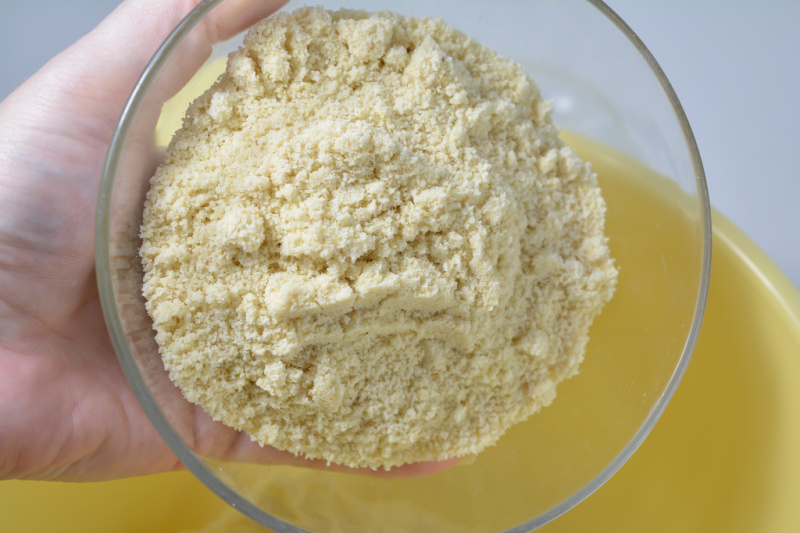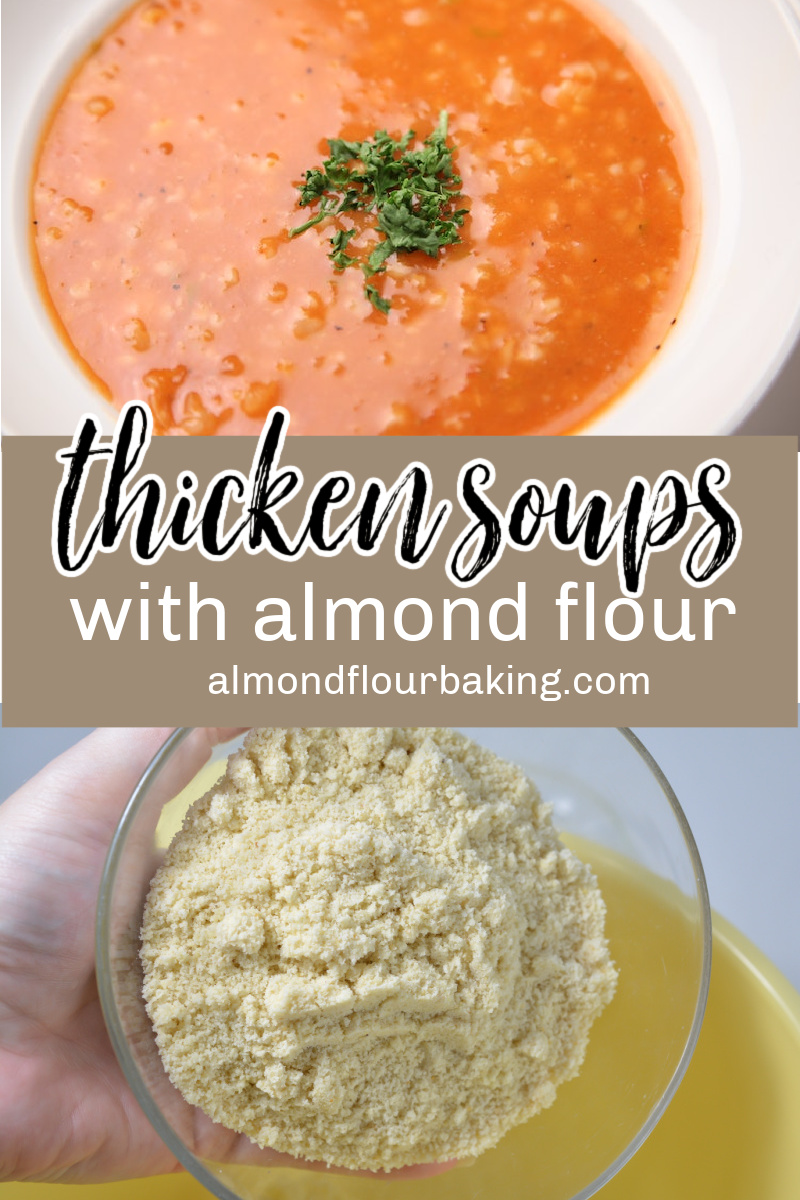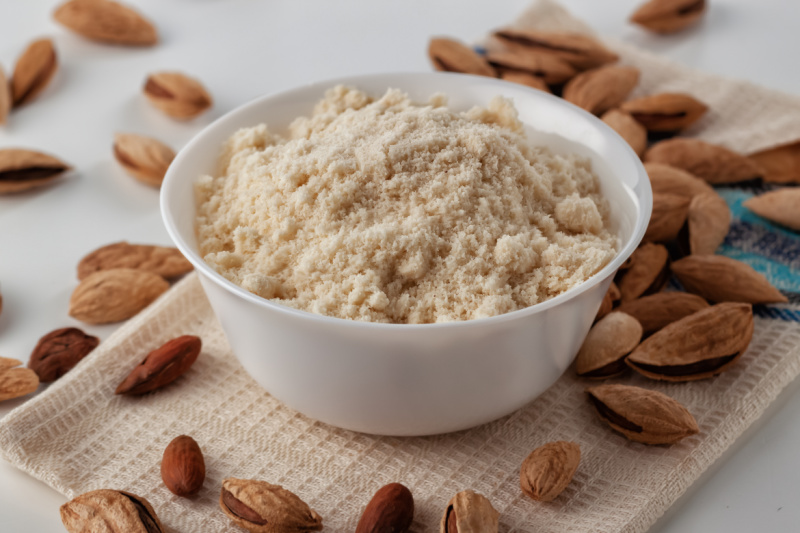Can you thicken soup with almond flour? find out how to use almond flour to thicken soups or thicken sauces.
Posts may be sponsored. This post contains affiliate links, which means I will make a commission at no extra cost to you should you click through and make a purchase. As an Amazon Associate I earn from qualifying purchases.

Can You Thicken Soup with Almond Flour?
If you want to thicken soups without using wheat flour, here are some tips. It is possible to use nut flours as a thickening agent but it’s different than using wheat flour.
Want a thicker soup but can’t use traditional flour? Nut flours like almond flour can help make your soup thicker. This choice is great for people who can’t have gluten. Plus, it adds a slight nutty taste to your soup that makes it even better.
While I mostly use almond flour for baked goods, you can use it for thickening soup. Now, let’s learn how to use almond flour to make your soups and sauces thicker and yummier.

Can you thicken liquid with almond flour?
Yes, you can thicken liquid with almond flour. However, it’s essential to keep in mind that almond flour does not have the same properties as traditional flour. It will not thicken your soup or sauce into a paste-like consistency, but it can certainly add extra thickness and bulk.
Almond flour, rich in fiber and protein, imparts a delightful, subtly nutty flavor while providing a thicker, heartier texture to your dish. Just remember to add it gradually and stir continuously to avoid lumps.

Can almond flour make a roux?
No, almond flour alone cannot make a roux. The unique properties of a roux come from the combination of wheat flour and fat, cooked together to create a thickening paste. While almond flour can add thickness and a nutty flavor, it doesn’t possess the same characteristics as all purpose flour to create a traditional roux.
However, you can experiment with a combination of almond flour, soy flour, and whey protein isolates to create a thickening agent. This mixture might not give you a classic roux, but it could provide a similar function while keeping your dish gluten-free.

Why isn’t my almond flour thickening?
If your almond flour isn’t thickening your soup as you’d expected, it’s likely due to the different absorption properties of almond flour compared to regular flour.
Almond flour doesn’t absorb liquid in the same way that regular flour does when mixed into a batter, or the way rice does in a soup.
However, it still enhances the overall body and heartiness of your soup. When using almond flour, expect a thicker, denser texture, instead of a drastically thickened consistency. This quality of almond flour makes it an excellent choice for creating hearty, satisfying dishes while maintaining a gluten-free diet.

Why add nuts or nut flour to soup
If you want to thicken soup with almond flour, here are some benefits.
Flavor Enhancement: Nuts add a unique, subtly nutty flavor to soups.
Texture Improvement: They provide a richer, denser texture, enhancing the overall feel of the soup.
Nutrition Boost: Nut flours are rich in protein, fiber, and healthy fats.
Gluten-Free: They offer a gluten-free alternative for those with dietary restrictions.
Calorie Dense: Nuts can add a caloric boost to your meals, aiding in weight gain efforts.
Work as a Thickener: While not as effective as regular flour, they can still add bulk to your soup.
Versatility: Nuts are versatile and can be used in various types of soups and stews.
Easily Digestible: They are generally easier on the stomach and more digestible than all purpose flour.
Low Glycemic Index: Nuts don’t spike blood sugar levels like traditional flour can.
Satiety: The healthy fats and protein in nut flour can help you feel full longer.
Just grind your almonds down until you have 1 to 2 cups. You don’t have to grind it into a smooth texture like flour.
Gluten free ways to thicken soup
Cornstarch: This common kitchen ingredient can be mixed with a little cold water to create a slurry, then stirred into the soup to thicken it.
Tapioca Flour: Another gluten-free option, this starchy flour thickens quickly and provides a glossy sheen to soups.
Potato Starch: This option works like cornstarch but is derived from potatoes. It’s an excellent choice for thickening potato-based soups.
Arrowroot: This powder thickens at a lower temperature than cornstarch, making it ideal for delicate soups.
Xanthan Gum: A little goes a long way with this powerful thickener. It’s best for creamy soups.
Rice or Quinoa: Cooked and pureed rice or quinoa can add body to your soup without altering the flavor.
Vegetable Puree: Blending a portion of your soup’s vegetables and adding them back into the pot can naturally thicken your soup.
Coconut Cream or Milk: These can add a rich, creamy texture to your soup, as well as a slight coconut flavor.
Egg Yolks: Beaten yolks can be slowly introduced to your soup to thicken it while adding a creamy texture.
Chia Seeds: These seeds absorb liquid and expand, creating a gel-like substance that can add thickness to your soup.

Keto ways to thicken soup
Almond Flour: As discussed earlier, almond flour can add a thicker, heartier texture to your soup, while being a keto-friendly option.
Coconut Flour: Much like almond flour, coconut flour can also be used to add thickness and a subtle hint of flavor to your soups.
Flaxseed Meal: This is another great low carb option that can be used as a thickener. It also adds a dose of healthy fats and fiber.
Psyllium Husk: Psyllium husk is a form of fiber that can absorb water and become gel-like, making it an excellent thickening agent.
Xanthan Gum: This is a powerful thickener, often used in gluten-free baking. A little goes a long way, so use sparingly.
Cream Cheese: Adding cream cheese to your soup can result in a rich, creamy texture. Ensure to choose full-fat cream cheese for keto-friendly option.
Heavy Cream or Sour Cream: Heavy cream can add a rich, creamy, and thick consistency to your soup and is an excellent choice for keto diets.
Egg Yolks: Yolks can add a velvety thickness to your soup, but be sure to temper them first to avoid curdling.
Cheese: Cheese can be a wonderful way to add creamy thickness to your soup. Harder cheeses can be grated into the soup, while softer ones can be cubed or torn.
Vegetable Puree: Pureeing low-carb vegetables like cauliflower or broccoli and adding them to your soup can add body and thickness without adding too many carbs.
How to make a creamy soup on the keto diet
Creating a creamy soup while sticking to a keto diet involves a few simple strategies that enhance texture and add richness without packing in the carbs. Here are ten ways to do it on a low-carb diet:
Use full-fat dairy: Heavy cream, full-fat milk, or cream cheese can add richness and creaminess to your soup.
Add pureed vegetables: Low-carb vegetables like cauliflower, broccoli, or zucchini can be cooked and pureed, then added to the soup for a creamy texture. This works well with a carrot soup.
Mix in cheese: Hard cheeses can be grated into the soup for a subtle creaminess, while soft cheeses can be melted in for a richer effect.
Incorporate coconut cream or coconut milk: These can lend a rich, creamy texture and a slight hint of coconut flavor. This works well in coconut-based soups.
Employ almond or coconut flour: While they won’t make the soup as thick as regular flour would, they do provide a pleasant thickness and nutty flavor.
Include egg yolks: Beaten egg yolks can be slowly introduced into the soup, thickening it and adding a creamy texture.
Thicken with xanthan gum: It’s a powerful low-carb thickener that can add a creamy consistency.
Use avocado: Avocado can be blended and added to the soup for a creamy texture and added health benefits.
Add a mayo emulsion: Make sure to choose a keto-friendly mayo. It can add a tangy, creamy texture to your soup.
Blend in tofu: Silken tofu can be blended and mixed into your soup to add creaminess.
Tips to thicken soups with almond butter
Measurement Matters: When adding nut butter to thicken your soups, it’s crucial to measure the ingredients correctly. Start with a small amount, and gradually add more if required. Too much can alter the soup’s taste and make it overly thick.
Blending is Key: To ensure the almond butter is evenly distributed throughout the soup, blend the soup after adding the nut butter. This will not only help to thicken your soup but also incorporate the nutty flavor of almond butter evenly.
Heat it Up: Almond butter tends to thicken more effectively when heated. Therefore, add it while the soup is still on the stove and stir it in over heat. This will activate the thickening properties of the nut butter and help it to mix in smoothly.
Best gluten free flour to thicken soup
Cornstarch: A little cornstarch mixed with cold water creates a slurry that can be stirred into the soup, thickening it without imparting any flavor.
Tapioca Flour: This gluten-free flour thickens rapidly and imparts a glossy sheen to your soup.
Potato Starch: Derived from potatoes, this thickener is great for potato-based soups, working similarly to cornstarch.
Arrowroot Flour: Ideal for delicate soups, arrowroot powder thickens at lower temperatures compared to cornstarch.
Rice Flour: Rice flour doesn’t alter the flavor of the soup and acts as a good thickening agent, especially for Asian-style soups.
So, the next time you want to thicken soup with almond flour, I hope you remember these tips. Why not try these almond flour buns next?
Related Reading
Ellen is a busy mom of a 25-year-old son and 29-year-old daughter and a grandma to an adorable girl. She owns 6 blogs and is addicted to social media. She shares simple tips and recipes for baking with almond flour. If you’d like to work together, email [email protected] to chat.




